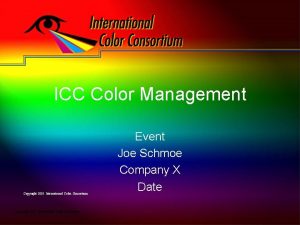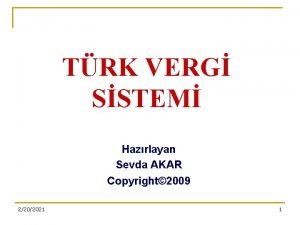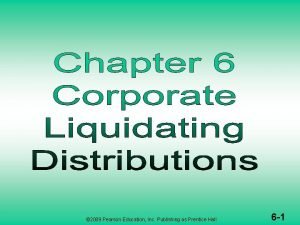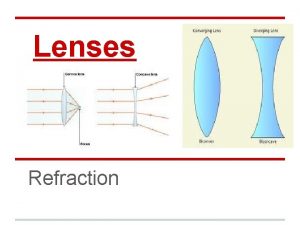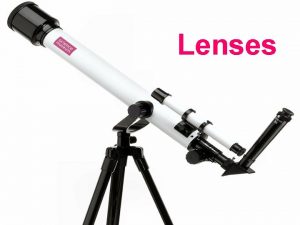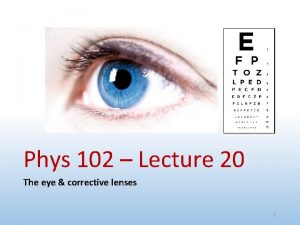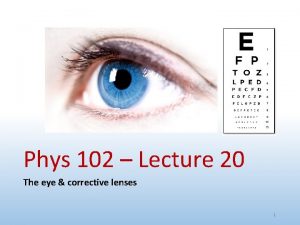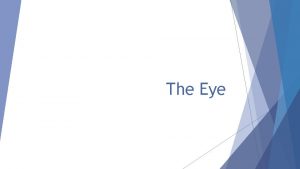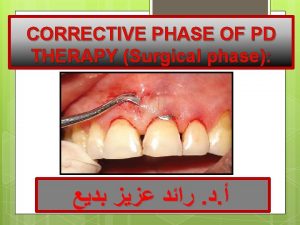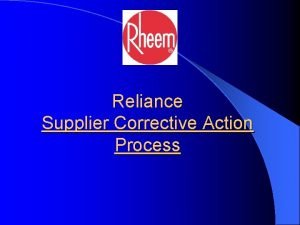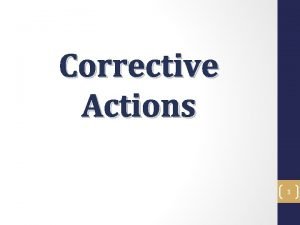The Human Eye Corrective Lenses Copyright 2009 Pearson












- Slides: 12

The Human Eye; Corrective Lenses Copyright © 2009 Pearson Education, Inc.

The Human Eye; Corrective Lenses The Human Eye Resembles a camera in its basic functioning, with an adjustable lens, the iris, &the retina. Copyright © 2009 Pearson Education, Inc.

In the eye, most of the refraction is done at the surface of the cornea. The lens makes small adjustments to focus at different distances. Copyright © 2009 Pearson Education, Inc.

Some Vision Terminology Near Point The closest distance at which eye can focus clearly. For a normal eye, this is about 25 cm. Far Point The farthest distance at which object can be seen clearly. For a normal eye, this is close to infinity. Nearsightedness Myopia: The far point is too close for the eye to function properly. Farsightedness Hyperopia: The near point is too far away for the eye to function properly. Copyright © 2009 Pearson Education, Inc.

Nearsightedness Can be corrected with a diverging lens. Copyright © 2009 Pearson Education, Inc.

Farsightedness Can be corrected with a converging lens. Copyright © 2009 Pearson Education, Inc.

Example: Farsighted eye. Sue is farsighted with a near point of 100 cm. What lens power should her reading glasses must have so that she can read a newspaper at a distance of 25 cm? Assume the lens is very close to the eye. Copyright © 2009 Pearson Education, Inc.

Example Nearsighted eye. A nearsighted person has near and far points of 12 cm and 17 cm, respectively. (a) What lens power is needed for this person to see distant objects clearly? (b) What then will be the near point? Assume that the lens is 2. 0 cm from the eye (typical for glasses). Copyright © 2009 Pearson Education, Inc.

Vision is blurry under water because light rays are bent much less than they would be if entering the eye from air. This can be avoided by wearing goggles. Copyright © 2009 Pearson Education, Inc.

Magnifying Glass A simple Magnifying Glass is a converging lens. It allows us to focus on objects closer than the near point, so that they make a larger, and therefore clearer, image on the retina. Copyright © 2009 Pearson Education, Inc.

See figures above! The Power of a magnifying glass is defined by its Angular Magnification: In the figures, N is the Near Point distance & f the Focal Length. If the eye is relaxed this becomes (assuming small angles!): If the eye is focused at the Near Point this can be written: Copyright © 2009 Pearson Education, Inc.

Example : A jeweler’s “loupe. ” An 8 -cm focal-length converging lens is used as a “jeweler’s loupe, ” which is a magnifying glass. Estimate: (a) The magnification when the eye is relaxed, (b) The magnification if the eye is focused at its near point N = 25 cm. Copyright © 2009 Pearson Education, Inc.
 Copyright 2009 pearson education inc
Copyright 2009 pearson education inc Copyright 2009 pearson education inc
Copyright 2009 pearson education inc Copyright 2009 pearson education inc
Copyright 2009 pearson education inc 2009 pearson education inc
2009 pearson education inc 2009 pearson education inc
2009 pearson education inc Copyright 2009 pearson education inc
Copyright 2009 pearson education inc International color consortium
International color consortium Dell all rights reserved copyright 2009
Dell all rights reserved copyright 2009 Reticolo di diffrazione zanichelli
Reticolo di diffrazione zanichelli Copyright 2009
Copyright 2009 Legge di stefan boltzmann zanichelli
Legge di stefan boltzmann zanichelli 2009 pearson education inc
2009 pearson education inc 2009 pearson education inc
2009 pearson education inc






